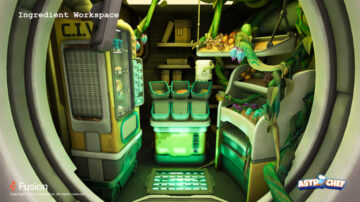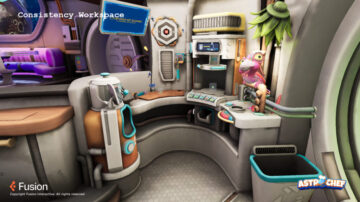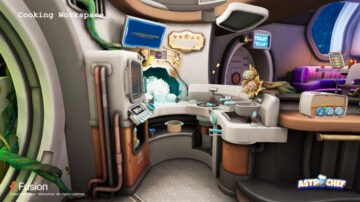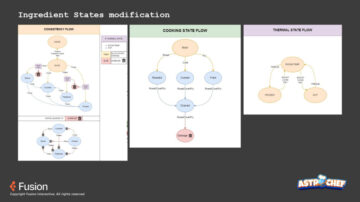Astro Chef
Company: Team 6 Game Studio
Software: Unreal 5
Platform: Meta Quest, Steam VR, PICO
Role: Level/Game Designer
Released: 2024
Development Time: ~1 year
Astro Chef is a VR culinary quest blending cooking, puzzles, and exploration. Master cosmic gadgets and exotic ingredients to serve unique alien patrons. Experiment, solve culinary puzzles, and explore new flavors in your quest for galactic fame.
Responsibilities:
During this process I had a mix of Level & Game Design responsibilities.
- Supporting the Game Design process in establishing the initial gameplay proof of concept & major gameplay systems iterations.
- Prototyping the ingredient processing mechanics and score progression systems to support the core gameplay loop.
- Iterating on the FTUE onboarding tutorial based on internal feedback.
- Writing and implementing new voicelines for the supporting character fitting the world narrative.
- Overhauling and balancing gameplay, progression and difficulty in both singleplayer and co-op gamemodes.
- Configuring newly made gameplay systems to fit the intended gameplay experience.
- Spearheading the Level Design process from pre-production until release for the kitchen gameplay space.
- Setting up and managing the Level Design pipeline and timeline.
- Establishing and communicating the intended cooking gameplay experience within the gameplay space through concepting, prototyping, greyboxing and documentation.
- Concept, prototyping, metrics and blockout, gameplay pass, testing and iteration, polish and bug fixing.
- Writing and maintaining a Level Design Doc to onboard parties into the level design process.
- Actively iterating upon the play space based on gathered internal feedback to the established bar-of-quality.
- Discussing and solving or communicating any high-level issues that arise.
- Maintaining direct communication with all departments and parties involved with the levels.
- Taking part in design brainstorming sessions and being a general team player.
- General QA & bug fixing
Level Design Highlights
Design
I started off by defining the playspace. Discussing with Design and the Game Director how the gameplay loop could be implemented into one space, a kitchen. Additionally sparring with environment art on the environmental concept. As the player would be spending the entirety of the game within this space, it was of utmost importance that all mechanics were easily accessible and grouped within logical spaces.
The player’s main mode of transportation within VR would be teleportation, therefore we chose for a “workspaces” solution. Grouping mechanics of a similar type within reach of a single teleport point. These workspaces were laid out in a manner that would support the logical gameplay progression and traversal from ‘getting ingredients’ all the way to ‘serving the final dish’.
Metrics Testing & Blockout
To ensure the accessibility of all mechanics within the workspaces to players of any height or age, I established the base metrics based on a small test. I created a VR scene in which testers of varied heights had to reach out to objects at varying distances, heights and size. Based on their comfortability, an ideal “goldilocks zone” for kitchen counter height, distance from player position, and object size for mechanics was established.
Using the metrics data, I created a blockout of the full kitchen space. This allowed us to test the gameplay loop within a representative VR space, gather feedback and iterate. After having reached a blockout result all stakeholders were excited about, the kitchen and restaurant could move into the production phase.
Final
Eventually we managed to design a play space that could integrate the core gameplay loop and all level specific progression mechanics or challenges within it. In cooperation with Art and Tech we included a great number of mechanics within the workspaces without it feeling to cramped or out of reach for person’s of any height, and supported our main traversal method as well as other optional ones. This made for a smooth and logical experience within the playspace allowing the player to focus on the challenge of the gameplay itself.
Game Design Highlights
Cooking System
During the concepting phase, I helped Game Design out with brainstorming, sparring, documenting and prototyping the initial core gameplay loop. In cooperation with the other designers and the Game Director I was responsible for designing a system for cooking itself. How individual ingredients can have their states be adjusted by tools to form an ingredient for a dish. The goal was to, in a simplified manner, mimic real life cooking and the states an ingredient can be in.
In this case three different categories of states; consistency states, cooking states, and thermal states. Each tool would adjust one or more of these state categories to their corresponding state. However, depending on which states an ingredient was in, it could also lead to failure, the trash state.
To quickly be able to test these designs in game, I created an ingredient states prototype where the player could adjust the state of our “ingredients” with “tools”. Showcasing consistency through the ingredient mesh, cooking state through the ingredient material, and thermal state through external actors (a freeze mesh for frozen, and particles for hot).
Eventually merging the prototype with a gameplay loop prototype of another designer to form the first testable cooking gameplay loop.
Ingredient States Prototype
Cooking Gameplay Loop Prototype
Check out more of the game on the official website!








